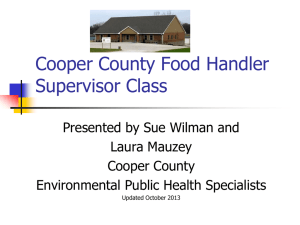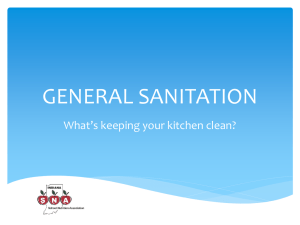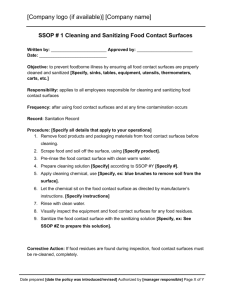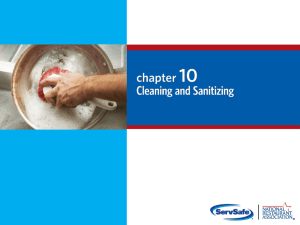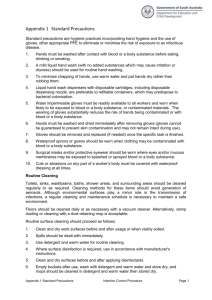SECTION 12: Cleaning and Sanitizing
advertisement
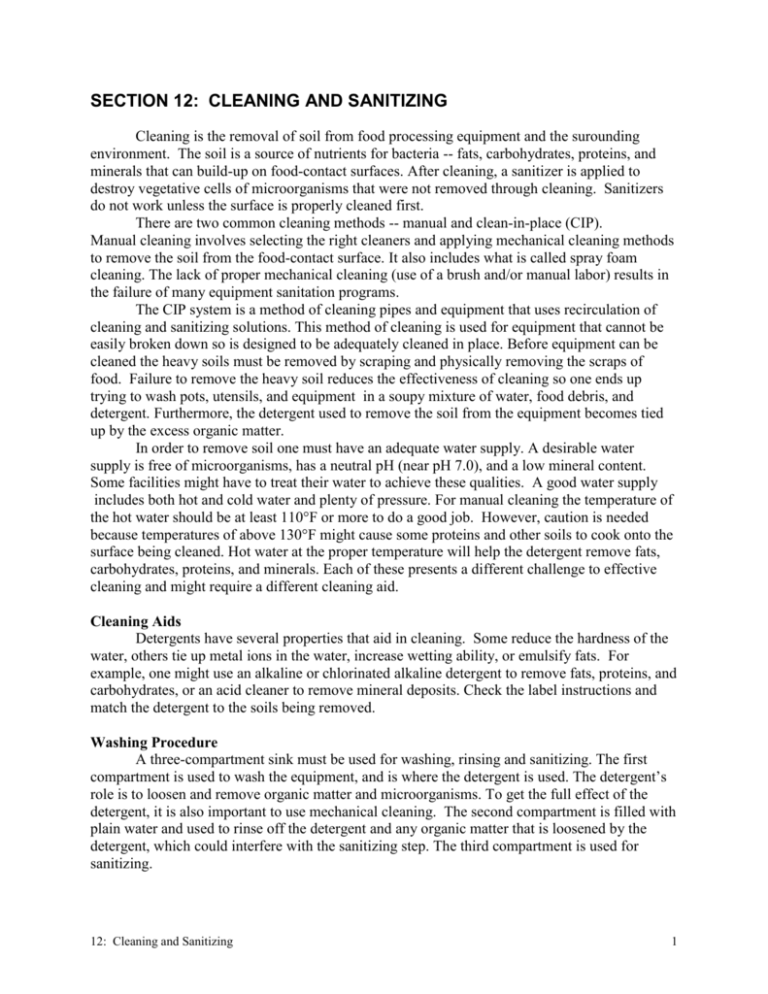
SECTION 12: CLEANING AND SANITIZING Cleaning is the removal of soil from food processing equipment and the surounding environment. The soil is a source of nutrients for bacteria -- fats, carbohydrates, proteins, and minerals that can build-up on food-contact surfaces. After cleaning, a sanitizer is applied to destroy vegetative cells of microorganisms that were not removed through cleaning. Sanitizers do not work unless the surface is properly cleaned first. There are two common cleaning methods -- manual and clean-in-place (CIP). Manual cleaning involves selecting the right cleaners and applying mechanical cleaning methods to remove the soil from the food-contact surface. It also includes what is called spray foam cleaning. The lack of proper mechanical cleaning (use of a brush and/or manual labor) results in the failure of many equipment sanitation programs. The CIP system is a method of cleaning pipes and equipment that uses recirculation of cleaning and sanitizing solutions. This method of cleaning is used for equipment that cannot be easily broken down so is designed to be adequately cleaned in place. Before equipment can be cleaned the heavy soils must be removed by scraping and physically removing the scraps of food. Failure to remove the heavy soil reduces the effectiveness of cleaning so one ends up trying to wash pots, utensils, and equipment in a soupy mixture of water, food debris, and detergent. Furthermore, the detergent used to remove the soil from the equipment becomes tied up by the excess organic matter. In order to remove soil one must have an adequate water supply. A desirable water supply is free of microorganisms, has a neutral pH (near pH 7.0), and a low mineral content. Some facilities might have to treat their water to achieve these qualities. A good water supply includes both hot and cold water and plenty of pressure. For manual cleaning the temperature of the hot water should be at least 110°F or more to do a good job. However, caution is needed because temperatures of above 130°F might cause some proteins and other soils to cook onto the surface being cleaned. Hot water at the proper temperature will help the detergent remove fats, carbohydrates, proteins, and minerals. Each of these presents a different challenge to effective cleaning and might require a different cleaning aid. Cleaning Aids Detergents have several properties that aid in cleaning. Some reduce the hardness of the water, others tie up metal ions in the water, increase wetting ability, or emulsify fats. For example, one might use an alkaline or chlorinated alkaline detergent to remove fats, proteins, and carbohydrates, or an acid cleaner to remove mineral deposits. Check the label instructions and match the detergent to the soils being removed. Washing Procedure A three-compartment sink must be used for washing, rinsing and sanitizing. The first compartment is used to wash the equipment, and is where the detergent is used. The detergent’s role is to loosen and remove organic matter and microorganisms. To get the full effect of the detergent, it is also important to use mechanical cleaning. The second compartment is filled with plain water and used to rinse off the detergent and any organic matter that is loosened by the detergent, which could interfere with the sanitizing step. The third compartment is used for sanitizing. 12: Cleaning and Sanitizing 1 Sanitizers There are three ways to sanitize – chemicals, heat, or radiation. As radiation is not practical for equipment sanitation in most food facilities, only heat and chemical sanitizers will be discussed. Chemical sanitizers are the most common sanitizers used. There are four types -chlorine; iodine; quaternary ammonium ; and acid. Chlorine is the most common, but iodine, quaternary ammonium or quats, and acids are also used. The factors that can affect how well sanitizers work are things such as time of exposure, pH, temperature, and water hardness. With pH, generally the effectiveness of the sanitizer increases with decreasing pH. This is true for iodine, chlorine and acid sanitizers, but not quats. For all sanitizers, the higher the temperature the more effective the sanitizer, up to a point. At very high temperatures (above 120°F) chlorine and iodine start to be driven out of the sanitizing solutions as gases. Heat speeds up chemical reactions, reduces surface tension, and decreases viscosity. The minimum concentration that is effective differs for each type of sanitizer. Label directions should be followed. Chlorine is the most widely used sanitizer. Chlorine is effective at the following concentrations depending upon contact time and water temperature. With a water temperature of 120°F or above: 25 parts per million (ppm) chlorine with a contact time of 10 seconds is adequate. Between 100 and 120°F: 50 ppm chlorine for 7 seconds works. Below 100°F: 100 ppm chlorine for 10 seconds is needed. With a particularly high water pH, (those above pH 10.0) some of these values might change. Iodine requires a concentration of 12.5 ppm with a minimum water temperature of 75°F and a contact time of 30 seconds. Quaternary ammonium requires a concentration of 150 to 400 ppm with a minimum water temperature of 75°F and a contact time of 30 seconds. Water hardness might effect quat. sanitizers. The water hardness should be known before using this sanitizer. Table 1. Summary of chemical sanitizing agents. Minimum concentration Minimum Temperature Minimum contact time Chlorine – 25 ppm 120°F 10 seconds Chlorine – 50 ppm 100°F 7 seconds Chlorine – 100 ppm 55°F 10 seconds Iodine – 12.5 ppm 75°F 30 seconds Quaternary ammonium – 150-400 ppm 75°F 30 seconds 12: Cleaning and Sanitizing 2 The above recommendations assume: pH 10 or less for chlorine solutions, pH 5 or less for iodine solutions, and 500mg/l hardness for quaternary ammonium. The manufacturer recommendations should always be followed for sanitizing solutions. There are advantages and disadvantages for each of the chemical sanitizers. Chlorine is inexpensive and effective against all vegetative pathogens. However, it is easily inactivated by organic matter and can be corrosive to equipment. At very high temperatures chlorine is unstable and is driven out of the sanitizing solution as a gas. Iodine is effective over a wide temperature range, not irritating to skin, and the strength of the solution is easily indicated by its color. However, it can discolor white walls, might be corrosive is unstable at high temperatures, and is more expensive than chlorine. Quaternar ammonium is effective even in the presence of organic matter, can be combined with detergents, and have a residual effect after application. But, they are not very effective against gram negative organisms (such as those found in seafood processing facilities) and their efficiency is reduced in hard water. Acid sanitizers are non-corrosive and are effective against vegetative cells. However, they require a long contact time and might be ineffective at a pH above 3.0. Table 2. Advantages and disadvantages of chemical sanitizers Chemical Advantages Disadvantages Chlorine Inexpensive Kills all tpes of vegetaive cells Rinse usually not required Inactivated by organics Somewhat corrosive Unstable at high tempreatures Iodine Inexpensive Strength is visually discernable Effective over a wide temperature range Non-irritating to skin May discolor white walls Corrosive at high tempreatures More expensive than chlorine – rinse may be required Unstable at high temperatures Quaternary Ammonium Compounds Resistant to organic matter Can be combined with detergents Has some residual effectiveness following application Not as effective against gram nvegative organisms Efficacy may be reduced by hard water Acid Non-corrosive Kills vegetative cells Requires long contact time May be ineffective at pH 12: Cleaning and Sanitizing 3 above 3.0 Sanitizer strengths should be checked often, because concentration changes. The most commonly used method of testing is test strips, which change color and which are then compared against a standard color to provide a sanitizer level. A different type of test strip must be used for each type of sanitizer. The sanitizer must be matched with the test strip. Both moist and dry heat can be used as effective sanitizers depending on the situation. If heat is used, a minimum temperature and exposure time of the heat is necessary for sanitizing to be effective. For example, if steam is used the minimum temperature should be 200°F for 5 minutes, but if water is used the temperature must be at least 170°F for 5 to 20 minutes depending upon the application. If dry heat is used the minimum temperature is 180°F for 20 minutes. Table 3. Heat as a Sanitizer Medium Temperature Time Steam 200°F 5 minutes Water 170°F 5-20 minutes Dry Heat 180°F 20 minutes Hot water is commonly used as a sanitizer, especially in foodservice operations, such as a dishwashing machine. Larger operations use large multi-tank conveyor washing machines. A conveyor carries dishes through the washing, rinsing and sanitizing tanks. The hot water is used in the sanitizing step. Proper sanitizing means that the temperature of the utensil being sanitized is heated to at least 160°F. Some of that heat builds up in the utensils as they travel through the 150°F to 165°F wash and rinse sprays in the dishwasher. The remaining heat accumulates as the utensils receive the sanitation spray. Generally, the water entering the sanitizing spray mechanism must be at least 180oF. The exception is with stationary racks, single-temperature machines allow the minimum wash temperature can be 165°F. The equipment should be equipped with a thermometer to ensure adequate temperatures. There is some cooling of the water as it is sprayed over the utensils. But, the water must be hot enough to raise the temperature of the utensils to 160°F or more. Another important factor is the pressure of the spray. Too much pressure, causes atomization of the water droplets resulting in a spray that cools too quickly before reaching the utensils. On the other hand, too little pressure might result in an uneven spray. Generally 15 to 25 pounds per square inch pressure works best. Not all dishwashers have pressure gauges. Most have their own pump that creates water pressure. The pressure delivered 12: Cleaning and Sanitizing 4 by these pumps is pre-set at the factory and is not likely to change dramatically over time. Therefore, a gage is not needed. Cleaning frequency Cleaning frequencies for different types of equipment might vary. For example, cutting boards must be cleaned and sanitized every four hours. This removes bacteria that might be present before they can multiply to dangerous levels. The key here is to break the cycle of growth before it leaves the lag phase. Cutting boards also need to be cleaned between different uses to avoid cross-contamination. For example, if the cutting boards were first used with a raw product, they would need to be washed and sanitized before they were used with a cooked readyto-eat product. To prevent cross-contamination, pots, pans and other food handling equipment which have contained raw Food, or have contained cooked Food, need to be cleaned and sanitized before they are used again. Cross-contamination can also occur between different types of raw foods. For example, after cutting raw poultry on a cutting board, it must be cleaned and sanitized before cutting raw beef because the beef might be cooked to a temperature lower than needed to eliminate the added contamination from the chicken. The four-hour rule does not apply in every situation. For example, equipment used in a cold room, like a meat saw, does not need to be cleaned as often. Once a day might be adequate. This is because microbial growth is slower in colder temperatures. The other example is for Food that are raw and will be cooked before consumption, like fish. Cleaning and sanitizing here is for removal of filth. It is not as critical to stop pathogen growth before it leaves the lag phase. And, pathogen growth is likely to be slower in raw foods because of the presence of competing microorganisms. Storage of cleaned and sanitized equipment is also important. Utensils must be stored so that they can adequately drain or moisture will be trapped -- contributing to microbial growth. They should be stored so they will not be re-contaminated, that usually means they should be upside down or covered. Foam cleaning is used to clean large pieces of equipment which cannot be moved to a sink for washing. Foam cleaner, which contains detergent, is applied at low pressure from an applicator wand or “spray gun”. This foam clings to the equipment surfaces and loosens the soil. After foaming the equipment is rinsed to remove the cleaner and soil. In some cases a sanitizing spray might be used as the rinse. It might seem like the detergent would interfere with the sanitizer, but in this case a fresh solution of sanitizer is continually applied to the surface. Because the sanitizing solution is not recycled, it is not affected by the detergent. In the dairy industry, as well as others, CIP is used for cleaning sanitary pipes with clamp fittings, welded pipelines, transport tankers and silo-type storage tanks. The ability of the welded pipes and bulk silo tanks to be cleaned by a CIP system, has been established by the equipment manufacturers, food industry representatives and government regulatory agencies. Otherwise the equipment would need to be constructed in a way that provides for inspection access. CIP systems are designed to circulate chemical detergent solutions, water rinses, and sanitizers over all food-contact surfaces. The minimum flow rate is generally 5 feet per second or greater. Some parts of the equipment such as thermometers, plug valves, and other parts which are not designed for CIP cleaning, have to be removed from the equipment and washed manually. The equipment piping might have to be reconfigured to facilitate the CIP system. Following cleaning the equipment would be reconfigured to handle product. 12: Cleaning and Sanitizing 5 A good example of CIP cleaning is milk pasteurizing systems. Pipes must be reconfigured or additional valves used to facilitate the flow of the rinsing, cleaning and sanitizing solutions in these systems. After the connections are made, the equipment is flushed with tempered water at around 120°F. Flushing continues until the rinse water runs clear at the downstream end of the line. Then, detergent is circulated for a preset time and temperature to assure removal of all soil. The detergent is followed by another rinse, and sometimes by an acid wash. The acid wash is to eliminate milkstone build-up. The acid wash is also followed by a clear water rinse. After rinsing, the system sanitizes. Any of the sanitizers that we mentioned can be used. A number of firms use hot water at a temperature of 170°F or more, which is circulated for five minutes. Another common sanitizer for CIP systems is steam, which is used almost exclusively in the dairy industry. This involves exposing the system to steam for at least 15 minutes once the temperature of the condensate at the outlet end has reached 170°F. Prepared by: Angela M. Fraser, Ph.D., Associate Professor/Food Safety Education Specialist, NC State University Souod R. Alani, Ph.D., Visiting Scholar, NC State University All content was adapted from the FDA course “Food Microbiological Control” prepared in 1998. 12: Cleaning and Sanitizing 6

